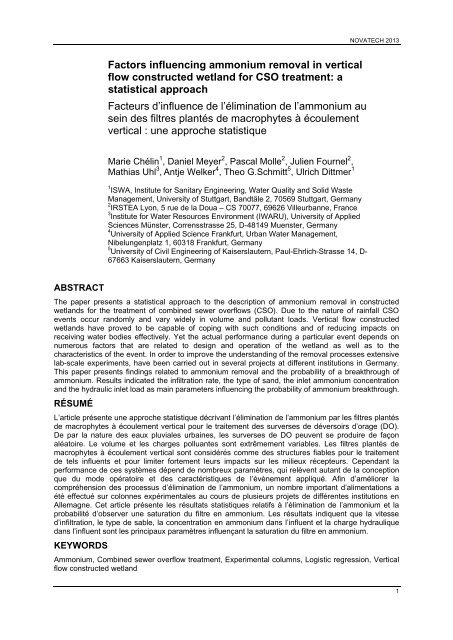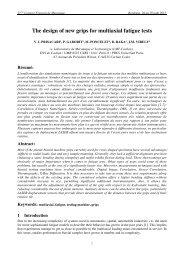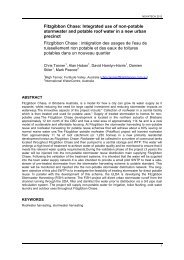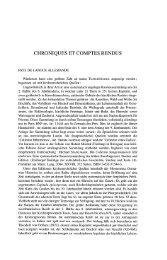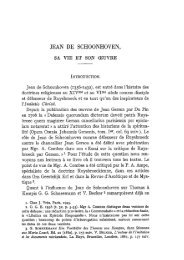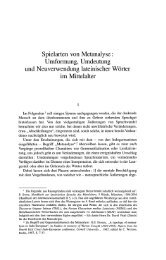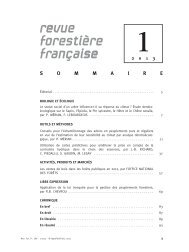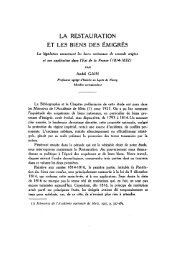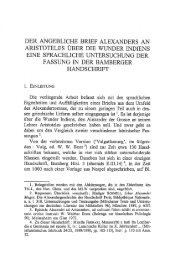communication novatech
communication novatech
communication novatech
Create successful ePaper yourself
Turn your PDF publications into a flip-book with our unique Google optimized e-Paper software.
NOVATECH 2013<br />
Factors influencing ammonium removal in vertical<br />
flow constructed wetland for CSO treatment: a<br />
statistical approach<br />
Facteurs d’influence de l’élimination de l’ammonium au<br />
sein des filtres plantés de macrophytes à écoulement<br />
vertical : une approche statistique<br />
Marie Chélin 1 , Daniel Meyer 2 , Pascal Molle 2 , Julien Fournel 2 ,<br />
Mathias Uhl 3 , Antje Welker 4 , Theo G.Schmitt 5 , Ulrich Dittmer 1<br />
1 ISWA, Institute for Sanitary Engineering, Water Quality and Solid Waste<br />
Management, University of Stuttgart, Bandtäle 2, 70569 Stuttgart, Germany<br />
2 IRSTEA Lyon, 5 rue de la Doua – CS 70077, 69626 Villeurbanne, France<br />
3 Institute for Water Resources Environment (IWARU), University of Applied<br />
Sciences Münster, Corrensstrasse 25, D-48149 Muenster, Germany<br />
4 University of Applied Science Frankfurt, Urban Water Management,<br />
Nibelungenplatz 1, 60318 Frankfurt, Germany<br />
5 University of Civil Engineering of Kaiserslautern, Paul-Ehrlich-Strasse 14, D-<br />
67663 Kaiserslautern, Germany<br />
ABSTRACT<br />
The paper presents a statistical approach to the description of ammonium removal in constructed<br />
wetlands for the treatment of combined sewer overflows (CSO). Due to the nature of rainfall CSO<br />
events occur randomly and vary widely in volume and pollutant loads. Vertical flow constructed<br />
wetlands have proved to be capable of coping with such conditions and of reducing impacts on<br />
receiving water bodies effectively. Yet the actual performance during a particular event depends on<br />
numerous factors that are related to design and operation of the wetland as well as to the<br />
characteristics of the event. In order to improve the understanding of the removal processes extensive<br />
lab-scale experiments, have been carried out in several projects at different institutions in Germany.<br />
This paper presents findings related to ammonium removal and the probability of a breakthrough of<br />
ammonium. Results indicated the infiltration rate, the type of sand, the inlet ammonium concentration<br />
and the hydraulic inlet load as main parameters influencing the probability of ammonium breakthrough.<br />
RÉSUMÉ<br />
L’article présente une approche statistique décrivant l’élimination de l’ammonium par les filtres plantés<br />
de macrophytes à écoulement vertical pour le traitement des surverses de déversoirs d’orage (DO).<br />
De par la nature des eaux pluviales urbaines, les surverses de DO peuvent se produire de façon<br />
aléatoire. Le volume et les charges polluantes sont extrêmement variables. Les filtres plantés de<br />
macrophytes à écoulement vertical sont considérés comme des structures fiables pour le traitement<br />
de tels influents et pour limiter fortement leurs impacts sur les milieux récepteurs. Cependant la<br />
performance de ces systèmes dépend de nombreux paramètres, qui relèvent autant de la conception<br />
que du mode opératoire et des caractéristiques de l’évènement appliqué. Afin d’améliorer la<br />
compréhension des processus d’élimination de l’ammonium, un nombre important d’alimentations a<br />
été effectué sur colonnes expérimentales au cours de plusieurs projets de différentes institutions en<br />
Allemagne. Cet article présente les résultats statistiques relatifs à l’élimination de l’ammonium et la<br />
probabilité d’observer une saturation du filtre en ammonium. Les résultats indiquent que la vitesse<br />
d’infiltration, le type de sable, la concentration en ammonium dans l’influent et la charge hydraulique<br />
dans l’influent sont les principaux paramètres influençant la saturation du filtre en ammonium.<br />
KEYWORDS<br />
Ammonium, Combined sewer overflow treatment, Experimental columns, Logistic regression, Vertical<br />
flow constructed wetland<br />
1
B6 - TRAITEMENT N & P / N & P TREATMENT<br />
NOMENCLATURE<br />
β<br />
- value of Xi corresponding to a DP d duration of the dry period before the<br />
0<br />
(i-1)<br />
reference situation<br />
feeding<br />
β<br />
L mg -1 regression coefficient related to the FR m s -1 filtration rate<br />
CNH4<br />
-N,in<br />
inlet ammonium concentration<br />
<br />
d -1 regression coefficient related to the h mm inlet hydraulic loading<br />
DP<br />
in(i)<br />
duration of the dry period before the<br />
feeding<br />
β - regression coefficient related to the L g m -3 inlet ammonium load of the last event<br />
FR<br />
NH 4 ,in(i-1)<br />
filtration rate<br />
β<br />
mm -1 regression coefficient related to the L g m -3 outlet ammonium mass of the last event<br />
h in<br />
NH 4 ,out(i-1)<br />
inlet hydraulic loading<br />
β m 3 g -1 regression coefficient related to the<br />
LNH 4 ,ret.<br />
ammonium mass retained during the<br />
last event<br />
β - regression coefficient related to the<br />
sand<br />
type of sand<br />
L<br />
NH 4<br />
,ret.(i-1)<br />
<br />
p breakth./ref.<br />
<br />
g m -3<br />
ammonium mass retained during the last<br />
event<br />
- probability of a breakthrough under the<br />
reference situation<br />
C mg L -1 inlet ammonium concentration of the p(breakth./X<br />
i) - probability of a breakthrough<br />
NH4<br />
-N,in(i)<br />
studied event<br />
mg L<br />
C<br />
-1<br />
inlet ammonium concentration of the Cu - uniformity coefficient<br />
NH 4 ,in(i-1) last event<br />
C mg NH4<br />
-N,out(i-1)<br />
L-1 mean outlet ammonium concentration V m 3 filter material volume<br />
filter<br />
of the last event<br />
d10 mm first percentile diameter of the grain<br />
size distribution<br />
d60 mm sixth percentile diameter of the grain<br />
size distribution<br />
d90 mm last percentile diameter of the grain<br />
size distribution<br />
INTRODUCTION<br />
V m 3 inlet volume of the last event<br />
in(i-1)<br />
V<br />
out(i-1)<br />
m 3<br />
outlet volume of the last event<br />
X - linear combination of explanative<br />
i<br />
variables<br />
Combined sewer overflows (CSOs) are known to highly impair the physical, chemical and ecological<br />
quality of water courses (Bertrand-Krajewski et al., 1998; Hall et al., 1998). The toxic impact of unionized<br />
ammonia (NH 3 ) on water organisms is considered as one of the most relevant ecological<br />
effects (Borchardt and Sperling, 1997; Holzer and Krebs, 1998). At high pH values and high<br />
temperatures NH 3 originates from less toxic ionized ammonium (NH 4 ) that is emitted via CSO<br />
discharges.<br />
In Germany, the standard strategy to control CSO emissions and to reduce impacts on receiving water<br />
bodies is to provide storage volume at CSO structures. After the rain event the retained volume is<br />
conveyed to the wastewater treatment plant (WWTP). If the receiving water body is particularly<br />
sensitive the remaining CSO discharge is treated in Vertical Flow Constructed Wetlands (VFCW).<br />
Such systems are by now widely used. In order to improve the understanding of the removal<br />
processes and to optimize the design of the systems intensive research has been carried out over the<br />
last 20 years (see Uhl and Dittmer, 2005; Dittmer and Schmitt, 2011, Henrichs et al., 2007;<br />
Langergraber et al., 2009, Woźniak et al., 2007).<br />
Concerning ammonium the results consistently indicate, that removal mainly occurs as a two-step<br />
process. Ammonium is adsorbed by the filter media during the feeding and then biologically degraded<br />
during rest period before the next event begins. Ammonium is retained mainly by (i) biotic adsorption<br />
on biomass and/or (ii) abiotic cationic exchange between liquid phase and filter material (Vymazal,<br />
2007). The sorption process can be described by isotherms, which are based on an equilibrium<br />
hypothesis between the adsorbed and dissolved phases. If the ammonium load of the inflow exceeds<br />
the sorption capacity of the filter media this leads to a breakthrough (Zhao et al., 2010; Vymazal, 2007;<br />
Woźniak et al., 2007).<br />
In several projects lab-scale filter columns have been used with only slight differences in the<br />
experimental setup. The projects had different aims and scopes. Some aimed at the development of<br />
deterministic models and their calibration (see Dittmer et al., 2005, Meyer et al., 2008; Meyer et al.,<br />
2012). Results show that the actual performance during a particular event depends on numerous<br />
factors that are related to design and operation of the wetland as well as to the characteristics of the<br />
event. Yet the number of experiments in each project was too small to apply multivariate statistics and<br />
2
to describe the influence of each factor in detail.<br />
NOVATECH 2013<br />
In the presented study data from various projects were collected and subjected to a consistent<br />
statistical analysis. The aim was to quantify the influence of the most relevant factors on the<br />
ammonium removal.<br />
1 1 MATERIALS AND METHODS<br />
1.1 1.1 Experimental setup<br />
Experiments were designed to reproduce full-scale RSFs in one dimension. The filter consists of<br />
different layers of porous media inside Plexiglas columns (inner diameter: 195 mm, total height: 2.30<br />
m) (figure 1).<br />
Figure 1: Experimental columns (according to Woźniak, 2008)<br />
The columns were fed by a pump with composite combined sewage. The water passes a 1 m layer of<br />
sandy filter media. Only in one project the layer was 0.75 thick. Gravel (2/8 mm) on top of the sand<br />
was supposed to limit erosion. The filter was supported by a 0.25 m gravel layer (2/8 mm). The outflow<br />
was limited by a peristaltic pump. This corresponds to full scale plants where the filtration rate is kept<br />
constant by a flow regulator. After each loading event the columns were completely drained.<br />
In most experiments the filter material was river sand. Some others used lava sands. Each column<br />
contained only one type of filter material. Main characteristics of the material varied between the<br />
different projects within the ranges given in table 1.<br />
Table 1: Soil parameters of the tested filter materials<br />
sand d10 Cu= d60/d10 d90 porosity carbonates<br />
[mm] [-] [mm] [%] [%]<br />
lava sands (L) [0.06;0.10] [4;9] [1.20;2.00] [38;55] [2;22.4]<br />
river sands (R) [0.10;0.20] [3;6] [1.20;1.90] [32;47] [2;33.9]<br />
1.2 1.2 Feeding, Operation and Sampling<br />
Loading characteristics were chosen to represent real conditions. Realistic inlet concentrations and<br />
hydraulic loading sequences were obtained from literature values and from corresponding full-scale<br />
investigations (Woźniak, 2008, Dittmer and Schmitt, 2011). Wastewater was collected from municipal<br />
wastewater treatment plants (after primary sedimentation) and diluted with tap water to obtain<br />
concentrations within the range of CSO quality parameters.<br />
After installation of the experimental setup the columns were fed with hydraulic batches of 500 mm (=<br />
0.5 m³/m² filter ) regularly once or twice per week for a minimum time span of 8 weeks (installation<br />
period). This installation period was conducted in order to establish the biocoenosis in the filter media.<br />
After sorption capacity was well developed loading characteristics like hydraulic load, pollutant load<br />
and dry periods were varied.<br />
3
B6 - TRAITEMENT N & P / N & P TREATMENT<br />
Four different filtration rates (1 × 10 -5 , 2 × 10 -5 , 3 × 10 -5 and 5 × 10 -5 m s -1 ) were tested on river sands<br />
and three on lava sands (1 × 10 -5 , 5 × 10 -5 and 10 × 10 -5 m s -1 ). In all experiments inflow was much<br />
higher than the outflow. Thus, the filter was operated under saturated conditions most of the time. This<br />
represents typical hydraulic conditions at full scale plants.<br />
The limits of removal capacity were tested in single high load events (> 1.500 mm). Due to the limited<br />
retention volume of the filter columns (max. 1.0 m, see fig. 1) higher hydraulic loads had to be<br />
separated into batches. The next batch was always applied the column before the previous one had<br />
been totally infiltrated – in this way a re-aeration (and instant nitrification) was prohibited.<br />
55 high loads events were continuously monitored and investigated to estimate the breakthrough<br />
probability. Inflow samples were taken from each batch of the feeding. Outflow concentration was<br />
monitored in intervals ranging from 18 to 500 mm.<br />
1.3 1.3 Datasets and statistical analysis<br />
Table 2 summarizes the operational conditions of the dataset. A configuration is defined by a type of<br />
material coupled with specific filtration rate. The first line gives the range of the particular parameter,<br />
the second line the mean value.<br />
Table 2: Feeding conditions of columns<br />
sand config. number of<br />
events *<br />
[-] [10 -5 m s -1 ] [mg L -1 ] [mm] [d] [g m -3 sand]<br />
L1x10 -5 6 1<br />
[3.8; 8.9]<br />
6.7<br />
[501; 2538]<br />
1567<br />
[1; 12]<br />
5<br />
[2.32; 18.7]<br />
8.3<br />
lava sand (L)<br />
L5 x10 -5 1 5<br />
-<br />
15.7<br />
-<br />
499<br />
-<br />
1<br />
-<br />
6.7<br />
L10 x10 -5 4 10<br />
[6.0; 8.5]<br />
6.3<br />
[501; 2204]<br />
1243<br />
[1; 12]<br />
6<br />
[3.9; 12.5]<br />
5.7<br />
R2 x10 -5 20 1-2<br />
[1.3; 22.0]<br />
8.0<br />
[501; 2518]<br />
1554<br />
[1;67]<br />
7<br />
[2.2; 18.0]<br />
7.4<br />
river sand (R)<br />
R3 x10 -5 12 3<br />
[1.3; 39.0]<br />
17.8<br />
[501; 1109]<br />
698<br />
[1;40]<br />
10<br />
[0.1;13.7]<br />
3.9<br />
R5 x10 -5 12 5<br />
[4.0; 22.4]<br />
9.1<br />
[501; 1557]<br />
1010<br />
[1; 7]<br />
5<br />
[2.0; 10.1]<br />
5.6<br />
*method: DIN 38 406 T5; absolute uncertainty (AU): 0.0015 mg NH4-N L -1 ; quantitative limit (QL): 0.01 mg NH4-N L -1 or<br />
cuvette quick tests; AU: 0.05 mg NH4-N L -1 , QL: 0.015 mg NH4-N L -1<br />
Ammonium mass retained during the last event (<br />
) was calculated by subtracting outlet<br />
ammonium fluxes ( ) from applied ammonium load ( ).<br />
where:<br />
4<br />
and<br />
1.3.1 1.3.1 Description of the dataset and restrictions<br />
In order to ensure the reliability of the statistical model, the differences between grain size distributions<br />
of sands were neglected. Based on previous studies (Woźniak et al., 2007) the type of sand (river<br />
sand or lava sands) was considered to be much more important than grain size distribution.<br />
The results of columns with filtration rates of 1 x 10 -5 (43 feedings) and 2 x 10 -5 m s -1 (1 feeding) on<br />
river sand were put together for statistical analysis, because this differing filtration rate did not indicate<br />
differing treatment performances. Likewise the influence of the thickness of the porous media was<br />
neglected.<br />
A first analysis (principal component analysis) of the dataset showed that configurations with river<br />
sand were much more investigated than configurations with lava sands. The hydraulic and ammonium
NOVATECH 2013<br />
loads on R3x10 -5 and R5x10 -5 were generally lower than on R2x10 -5 . These heterogeneities are likely<br />
to impact directly the statistical results.<br />
1.3.2 1.3.2 Description of the model<br />
The aim of the statistical analysis was to quantify the probability of a breakthrough. Based on<br />
theoretical considerations six variables were considered to be relevant: (i) quantitative variables: inlet<br />
ammonium concentration, applied hydraulic load, duration of previous dry period, mass of ammonium<br />
retained in the column during the last event and (ii) qualitative variables: type of filter material and<br />
filtration rate.<br />
To estimate the breakthrough probability logistic regression was applied. The method allows<br />
expressing the modality of a binary variable as a linear function of quantitative and qualitative<br />
explanative variables (Dreiseiti and Ohno-Machado, 2002). The global model is:<br />
is the probability of ammonium breakthrough given the values of the variable Xi. is the probability<br />
of an absence of ammonium breakthrough and is equal to 1- .<br />
Since ammonium retention is a sorption process, the probability of a breakthrough must increase with<br />
the inlet ammonium load. However, the inlet ammonium concentration (<br />
hydraulic load (<br />
) and applied<br />
) were considered separately in order to take the hydraulic characteristics of the<br />
event into account. The variables and describe the part of the sorption<br />
capacity that is already used be ammonia from the previous event. The higher<br />
more sorption sites already taken are. But with progressing dry period (<br />
is, the<br />
) the capacity is<br />
regenerated by nitrification of the retained ammonium. is the value of corresponding to a<br />
reference situation for which no feeding is applied on a lava sands column with a filtration rate of 1 x<br />
10 -5 m s -1 which results in a probability of breakthrough close to 0.<br />
A breakthrough is assumed to occur when the calculated probability is higher than 50%. The best<br />
model was obtained by eliminating one-by-one the parameters (backward stepwise method) to<br />
minimize the Akaike Information Criterion (AIC) (Dreiseiti and Ohno-Machado, 2002). This criterion is<br />
based on the maximum likelihood estimation.<br />
The parameters β j were estimated by the maximizing the likelihood. The significance of these<br />
parameters was tested by the maximum likelihood ratio test with a level of 5%. Their confidence<br />
intervals were estimated through a normal law with at a level of 95%.<br />
The quality of the model was first assessed by a classification table so as to count up relevant and<br />
irrelevant predictions. The “true positive” (TP) correspond to the feedings classified as leading to a<br />
breakthrough whereas they led to a breakthrough. The “true negative” (TN) correspond to the feeding<br />
classified as “no breakthrough” whereas they did not lead to a breakthrough”. The “false positive” (FP)<br />
correspond to those for which the model predicted a breakthrough while they didn’t lead to one (table<br />
3).<br />
Table 3: Table of classification<br />
Observed\Predicted no breakthrough breakthrough total<br />
no breakthrough TN FP N<br />
breakthrough FN TP P<br />
total<br />
n=TP+FN+FP+TN<br />
Four indicators were calculated. The error rate was obtained by dividing the number of irrelevant<br />
5
B6 - TRAITEMENT N & P / N & P TREATMENT<br />
predictions by the total number of studied cases ( ). The sensibility indicates the ability of the<br />
model to predict the breakthrough apparition. It corresponds to the proportion of “true breakthroughs”<br />
among the total predicted breakthroughs ( ). Inversely, the specificity informs about the ability of<br />
the model to identify the absence of breakthrough. It is calculated by dividing the number of the “true<br />
negative” by the total number of predicted “negative” ( ).<br />
2 2 RESULTS<br />
2.1 2.1 Selection of the most relevant model<br />
The probability of a breakthrough is best represented by the logistic model:<br />
, where:<br />
The logistic regression showed that only four out of the tested six parameters significantly influence<br />
the appearance of a breakthrough: the type of sand, the ammonium inlet concentration, filtration rate<br />
and the applied hydraulic load. For other parameters, regression coefficients were not significantly<br />
different from 0, meaning that they have negligible influence on the probability of a breakthrough.<br />
Unexpectedly, the initial state of the column (expressed through the duration of dry period and the<br />
retained ammonium load during the previous feeding) does not appear as an influence factor.<br />
Regression coefficients of influence parameters are given in table 4.<br />
Table 4: Regression coefficients of the breakthrough probability predictive model (reference situation in bold)<br />
sand river sand lava sands<br />
[10 -5 m s -1 ]<br />
1 or 2 3 5 1 5 10<br />
-22.6 ± 0.1<br />
4.8 x 10 -3 ± 0.3 x 10 -3<br />
0.13 ± 0.01<br />
14.9 ± 0.5 0<br />
0 0.0 ± 1.1 3.5 ± 0.7 0 3.5 ± 0.7 10.7 ± 0.7<br />
In comparison with the reference situation, an increase of the filtration rate leads to an increase in the<br />
probability of a breakthrough, both for river sand or lava sands (positive regression coefficients). This<br />
highlights the influence of retention time for values higher than 3 x10 -5 m s -1 .<br />
For a given filtration rate, the probability of breakthrough is higher for river sand than for lava sands. In<br />
particular, for a given applied ammonium load, this probability is higher for river sand with a filtration<br />
rate of 1 or 2 x 10 -5 m s -1 than for lava sands with a filtration rate of 10 x 10 -5 m s -1<br />
( ; , see figure 3).<br />
It can be seen as well that an increase in the hydraulic load and the inlet ammonium concentration<br />
causes an increase in the breakthrough probability. However, respective values of β h and β [NH4] cannot<br />
directly be compared, since they do not have the same units and are involved in the regression<br />
equation in the shape of continuous explanative variables products (oppositely to the type of material<br />
and the filtration rate value). Finally, figure 3 summarizes the model results by describing the<br />
breakthrough probability against the inlet ammonium concentration for different configurations and<br />
feeding conditions.<br />
6
NOVATECH 2013<br />
Figure 2: Probability of getting a breakthrough as a function of inlet ammonium concentration for several feeding<br />
conditions<br />
The probability of a breakthrough is comparatively low for lava sands over the entire range of<br />
ammonium concentrations, hydraulic loads or filtration rate tested. This confirms the much higher<br />
sorption capacity of this material.<br />
Inversely, the breakthrough probability is constantly higher than 65% for river sand with filtration rate of<br />
5 x 10 -5 m s -1 , even at very low ammonium concentrations, for an applied hydraulic load of 1000 mm.<br />
However, when this hydraulic load reaches only 500 mm, the breakthrough probability decreases<br />
significantly (below 50% for an ammonium concentration of 11 mg NH4-N /L).<br />
In typical ranges of CSOs concentrations (between 3-30 mg NH4-N /L, Welker, 2004), the breakthrough<br />
probability is lower than 50% for all lava sands configurations independently from the applied hydraulic<br />
load. For river sand, a probability of 50% is reached for a hydraulic load of 500 mm with a filtration rate<br />
of 1 or 2 x 10 -5 m s -1 at the concentrations of 40 mg NH4-N /L. When the hydraulic load reaches 500 mm<br />
on the same column, this probability increases from 20 to 45% over the range of tested<br />
concentrations.<br />
2.2 2.3 Evaluation of the model<br />
Table 5 represents the classification table of the selected model. Results show a satisfying match<br />
between the observed and the predicted behavior of the filter. 9 events were improperly predicted,<br />
which corresponds to an error rate to 16%. The sensibility of the model is equal to 80%, whereas the<br />
specificity (well predicted behavior frequency) is equal to 84%.<br />
Table 5: Classification table of the logistic regression<br />
observed \ predicted no breakthrough breakthrough total<br />
no breakthrough 21 7 28<br />
breakthrough 2 25 27<br />
3 3 DISCUSSION<br />
total 23 32 55<br />
The model does not allow testing interactions between the different influence parameters. In particular,<br />
this study highlighted the influence of the filtration rate and the type of sand. It can be assumed that<br />
the combinations of river sand and high filtration rate (5 x 10 -5 m s -1 ) increase the risk of a<br />
breakthrough. However, not all possible combination between the media and the filtration rate were<br />
tested, which limits further interpretations. Moreover, lower hydraulic and ammonium loads were<br />
applied for the experiments on river sand with a filtration rate of 3 and 5 x 10 -5 m s -1 , which<br />
underestimate the impact of the high filtration rate on the probability of getting a breakthrough. Another<br />
logistic regression could be implemented with new regression coefficients taking into account these<br />
interactions. However, the global tested model has to remain simple to preserve its reliability.<br />
7
B6 - TRAITEMENT N & P / N & P TREATMENT<br />
The present study investigated the influence of the initial state of the column by a linear combination of<br />
the previous dry period and the retained ammonium load during the previous event<br />
( ). However, the model results did not indicate an influence<br />
of the initial ammonium being in the filter. This influence has been demonstrated on full-scale and on<br />
experimental pilots (Fournel et al., 2012; Dittmer, 2006). This can be explained by the fact, that this<br />
influence is not linear. In the next projects, it could be interesting to determinate the best way to take<br />
the initial state into account. Besides the dry period duration was generally sufficient to nitrify the major<br />
part of retained ammonium. Field experiments showed that nitrification of retained ammonia is almost<br />
completed after 2 or 3 days (Dittmer, 2006). In this study, 75% of the events were simulated after a dry<br />
period of 4 days or more.<br />
The sewage was obtained by diluting domestic wastewater with tap water. It is possible that this<br />
method does not reproduce the proportion of nitrogen compounds. In particular, the ratio between<br />
organic nitrogen and ammonium is not respected. While (Henze et al., 2002) estimated the quantity of<br />
organic nitrogen in a domestic wastewater between 35 and 40% of total ammonium, this proportion<br />
reaches 50 to 70% in CSO or stormwater (Taylor et al., 2005; Gervin and Brix, 2001). Under<br />
unsaturated conditions, organic ammonium is transformed into ammonium through ammonification<br />
(Lee et al., 2009). The use of an influent closer to a CSO would certainly involded more uncertainties<br />
on the statistical results.<br />
In order to simplify the model and to ensure the reliability, several influence parameters were<br />
neglected. In particular, the filter thickness varied between 0.75 and 1 m, which can influence the<br />
sorption capacity.However, several authors demonstrated that most of ammonium was retained in the<br />
upper zone of the column (von Felde and Kunst, 1997; Woźniak, 2008). Thus, this influence should be<br />
slight, which was confirmed by the graphical analysis.<br />
Likewise several sands with different characteristics (grains size distribution, porosity, percentage of<br />
carbonates) were grouped together in two types of sand (river sands and lava sands). There again,<br />
slight differences of behavior were observed between the different sands. However, the sands were<br />
associated to a given thickness (0.75 or 1 m). Thus the distinction between the effects of the material<br />
characteristics and the filter thickness is not possible. Moreover, some sands were fed only once,<br />
which do not allow highlighting the influence of their physical characteristics.<br />
The reliability of such a statistical model is based on the homogeneity of the dataset used. Indeed, in<br />
our case, the datasets presented some heterogeneity in terms of feeding conditions on the different<br />
configurations (number of feedings, dispersion of influent concentrations per configuration, etc.). Then,<br />
such heterogeneities create uncertainties during the data treatment and the calculation of regression<br />
coefficients. The implementation of a feeding program and protocol should be useful for further<br />
researches.<br />
Further research is needed to determine the inlet ammonium loading corresponding to the beginning<br />
of the breakthrough. In particular, a covariance analysis would allow predicting the value of a<br />
quantitative variable as a linear function of quantitative and qualitative variables. A first trial of such a<br />
study was implemented but results are not reliable enough to be presented so far.<br />
4 CONCLUSION AND OUTLOOK<br />
The graphical and statistical analysis highlighted the influence of the type of sand and the filtration rate<br />
on ammonium removal. The performance of the system is highly improved by the use of lava sands<br />
and low filtration rates (1 or 2 x 10 -5 m s -1 ). The aim of implementing a statistical analysis was to<br />
identify the importance of influencing parameters on the probability for a breakthrough. This analysis<br />
could only be conducted due to the large number of single events and especially high load data.<br />
Feeding conditions (hydraulic loads and ammonium concentration) as well as design have to be<br />
considered. The influence of initial state could not be taken into account, which certainly needs to be<br />
expressed otherwise.<br />
The statistical analysis included only high load events where time series of the outflow concentrations<br />
were measured. There is still a database of several hundred events with only composite samples that<br />
could be included. This would allow realizing a validation of the results. In particular, the presence and<br />
the relative impact of the tested variables can be verified.<br />
As the column experiments represented real design and operational conditions the model should be<br />
transferable to full scale plants. However, the results need to be validated and completed on full-scale<br />
8
NOVATECH 2013<br />
plants.<br />
LIST OF REFERENCES<br />
Bertrand-Krajewski, J.-L.,Chebbo, G., Saget A. (1998). Distribution of pollutant mass versus volume in stormwater<br />
discharges and the first flush phenomenon. Water Science and Technology (32/8), 2341-2356.<br />
Borchardt, D., Sperling, F. (1997). Urban stormwater discharges: ecological effects on receiving waters and<br />
consequences for technical measures. Water Science and technology (36), 173-178.<br />
Dreiseiti S., Ohno-Machado L. (2002). Logistic regression and artificial neural network classification models: a<br />
methodology review. Journal of Biomedical Informatics (35), 352-359.<br />
Dittmer, U. and Schmitt, T.G. (2011). Purification Processes in Biofilter Systems for CSO Treatment. Proceedings<br />
12th International Conference on Urban Drainage, Porto Alegre, Brazil.<br />
Dittmer, U. (2006). Prozesse des Rückhaltes und Umsatzes von Kohlenstoff- und Stickstoffverbindungen in<br />
Retentionsbodenfiltern zur Mischwasserbehandlung. PhD thesis. University of Kaiserslautern, 193 p.<br />
Dittmer, U.; Meyer, D.; Langergraber, G. (2005): Simulation of a Subsurface Vertical Flow Constructed Wetland<br />
for CSO Treatment, Water Science and Technology, Vol. 51, No. 9, 2005<br />
Fournel, J., Millot, Y., Molle, P., Grasmick, A. (2012). Purification efficiencies of vertical flow constructed wetland<br />
pilot units treating urban runoff: comparison of designs and interest in using zeolite as adsorbant material.<br />
Proceedings 13th International Conference on Wetland Systems for Water Pollution Control, Perth, Australia<br />
(under press).<br />
Gervin, L. and Brix, H., (2002) Removal of nutrients from combined sewer overflows and lake water in a verticalflow<br />
constructed wetland system. Water Science and Technology (44/11–12), 171–176.<br />
Hall, K.-J., McCallum, D.W., Lee K., Macdonald R., (1998). Characterization and aquatic impacts of combined<br />
sewer overflows in greater Vancouver British Columbia. Water Science and Technology (38), 9-14.<br />
Henrichs, M., Langergraber, G., Uhl, M. (2007). Modelling of organic matter degradation in constructed wetlands<br />
for treatment of combined sewer overflow. Science of the Total Environment 380(1-3), 196-209.<br />
Henze, M., Harromoës, P., La Cour Jansen; J., Arvin E. (2002).Wastewater Treatment: Biological and Chemical<br />
Processes.Berlin Heldelberg:Springer, 433p. ISBN 3-540-42228-5.<br />
Holzer, P., Krebs, P. (1998). Modelling the total ammonia impact of CSO and WWTP effluent on the receiving<br />
water. Water Science and Technology (38), 31-39.<br />
Lee, C.G., Fletcher, T.D., Sun G. (2009). Nitrogen removal in constructed wetland systems. Engineering Life<br />
Science( 9/1), 11–22.<br />
Langergraber, G., Giraldi, D., Mena, J., Meyer, D., Peña, M., Toscano, A., Brovellig, A., Korkusuz, A. (2009).<br />
Recent developments in numerical modelling of subsurface flow constructed wetlands. Science of the Total<br />
Environment (404), 3931-3943.<br />
Meyer, D., Dittmer, U., Forquet, N., Molle, P. (2012). Simplified modelling of constructed wetlands for combined<br />
sewer overflow treatment - results from German systems and discussion of adaptation in France. Proceedings<br />
of NOVATECH 2013, Lyon, france (this issue).<br />
Meyer, D.; Schmitt, T.G.; Woźniak, R.; Sommer, T.; Hagen, H. (2008): Results of long-term pollution-load<br />
simulations of lab-scale constructed wetlands for CSO treatment. 11th International Conference on Wetland<br />
Systems for Water Pollution Control, 790-796, Indore, India.<br />
Taylor, G.D., Fletcher, T.D., Wong, T.H.F., Breen, P.F., Duncan, H.P. (2005), Nitrogen composition in urban<br />
runoff-implications for stormwater management. Water Research (39/10), 1982-1989.<br />
Uhl, M., Dittmer, U. (2005). Constructed wetlands for CSO treatment: an overview of practice and research in<br />
Germany. Water Science & Technology (51/9), 23-30.<br />
Von Felde, K., Kunst, S. (1997). N- and COD-removal in vertical-flow systems. Water Science and Technology<br />
(35/5), 79-85.<br />
Vymazal, J. (2007). Removal of nutrients in various types of constructed wetlands. Science of the Total<br />
Environment 380(1-3), 48-65.<br />
Welker, A., (2004). Schadstoffströme im urbanen Wasserkreislauf – Aufkommen und Verteilung, insbesondere in<br />
den Abwasserentsorgungssystemen (Pollutant flows in the urban water cycle – fate and distribution,<br />
particulary in waste water systems). Postdoctoral lecture thesis, Institute of Environmental Engineering, Vol.<br />
20, University of Kaiserslautern, Germany.<br />
Woźniak, R. (2008). Ermittlung von Belastungsgrenzen an Bodensubtraten zur weitergehenden<br />
Mischwassersbehandlung in Retentionsbodenfiltern. PhD thesis. University of Kaiserslautern, 202 p.<br />
Woźniak, R., Dittmer, U. and Welker, A. (2007). Interaction of oxygen concentration and retention of pollutants in<br />
vertical flow constructed wetlands for CSO treatment. Water Science and Technology(56), 31-38.<br />
Zhao, Y., Zhang, B., Zhang, X., Wang, J., Liu, J., Chen, R. (2010). Ammonium removal from aqueous solution by<br />
zeolite X synthesized from halloysite mineral. Water Science and Technology (62), 937-946.<br />
9


